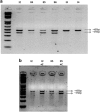A novel splicing mutation in the IQSEC2 gene that modulates the phenotype severity in a family with intellectual disability
- PMID: 26733290
- PMCID: PMC4970682
- DOI: 10.1038/ejhg.2015.267
A novel splicing mutation in the IQSEC2 gene that modulates the phenotype severity in a family with intellectual disability
Abstract
The IQSEC2 gene is located on chromosome Xp11.22 and encodes a guanine nucleotide exchange factor for the ADP-ribosylation factor family of small GTPases. This gene is known to have a significant role in cytoskeletal organization, dendritic spine morphology and synaptic organization. Variants in IQSEC2 cause moderate to severe intellectual disability in males and a variable phenotype in females because this gene escapes from X-chromosome inactivation. Here we report on the first splicing variant in IQSEC2 (g.88032_88033del; NG_021296.1) that co-segregates in a family diagnosed with an X-linked form of ID. In a percentage of the cells, the variant activates an intraexonic splice acceptor site that abolishes 26 amino acids from the highly conserved PH domain of IQSEC2 and creates a premature stop codon 36 amino acids later in exon 13. Interestingly, the percentage of aberrant splicing seems to correlate with the severity of the disease in each patient. The impact of this variant in the target tissue is unknown, but we can hypothesize that these differences may be related to the amount of abnormal IQSEC2 transcript. To our knowledge, we are reporting a novel mechanism of IQSEC2 involvement in ID. Variants that affect splicing are related to many genetic diseases and the understanding of their role in disease expands potential opportunities for gene therapy. Modulation of aberrant splicing transcripts can become a potent therapeutic approach for many of these diseases.
Figures




References
Publication types
MeSH terms
Substances
LinkOut - more resources
Full Text Sources
Other Literature Sources

